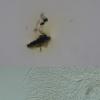
28-12-2025 12:08
Margot en Geert VullingsThis possible Karstenia was found on the bark of d

21-12-2025 21:32
Pol DebaenstHello, Garden, Burgweg 19, Veurne, BelgiumOn 10/1

26-12-2025 21:19
Arnold BüschlenPithyella chalaudii Priou. Ist als Bryoparasit in

21-12-2025 09:32
Hello.A tiny ascomycete found embedded in wood in

18-12-2025 21:17
Pol DebaenstThe identification took me to Byssonectria deformi

24-12-2025 17:08
Hulda Caroline HolteHello, I have found this propoloid ascomycete on
unknown mollisoioid discomycetes in taiwan
YI-SIOU CHEN,
19-09-2024 10:15
 Hello,
Hello,I am a master's student in Taiwan, and my research is investigating the diversity of discomycetes in Taiwan. Some uncertain mollisoioid discomycetes were found.
I organized the information in PDF files, with some simple descriptions and ML trees based on ITS.
Sample number: AL2401_05-1, PD2303_20, PD2303_04, NT2405_05
The sequences of AL2401_05-1 and Neobelonopsis acutata are similar, but the ascospores do not have obvious acute apices and are also shorter.
PD2303_20 belongs to the genus Neobelonopsis, but does not correspond to any similar sequence.
Not sure if PD2303_04 is Mollisia anserina?
NT2405_05 seems to be separated from Mollisiaceae? Not sure which genus it belongs to and what characteristics can be used to judge it?
I also have sequences from ITS and LSU if needed.
Thanks for your help.
CHEN,YI-SIOU
Hans-Otto Baral,
19-09-2024 10:44

Re : unknown mollisoioid discomycetes in taiwan
Many thanks for your interesting contribution! Your docus are very valuable, not only because most are in vivo.
In your trees you have numbers which are not explained, are they distances?
First I will comment on your 4th specimen: The clade with Tapesia cinerella 312.61 is the genus Pyrenopeziza s.l. (Pyrenopezizaceae), but all other strains of this part of the tree belong in Mollisiaceae. So it might be it is a matter of rooting the tree.
The species in question is clearly a Mollisia s.l. (with VBs in the paraphyses), with unusually large spores.
What you should test is the yellow or negative KOH reaction of the VBs (macroscopically or in a water preparation at low magnification by adding KOH).
I have a folder with one collection from Spain (by Unai Fernandez), but the spores are there much larger:
cortegadensis-like Quercus IKI bb 16-20 x 5-6 OCI 3.5-4 KOH yellow.
The KOH reaction was strong in that specimen.
From your scale the spores are a bit larger, 11-14 x 3.7-4.8 µm I think.
YI-SIOU CHEN,
19-09-2024 12:32

Re : unknown mollisoioid discomycetes in taiwan
The number represents bootstraps. The ML tree is attached to the file, but it is only a preliminary result and may not be complete. The sequence of my sample is also attached.
NT2405_05 has yellow pigment in 5% KOH. Does this represent a positive KOH reaction? The VBs of the sample seem to have disappeared because it has been dried.
Thanks for your reply!
NT2405_05 has yellow pigment in 5% KOH. Does this represent a positive KOH reaction? The VBs of the sample seem to have disappeared because it has been dried.
Thanks for your reply!
Hans-Otto Baral,
19-09-2024 21:56

Re : unknown mollisoioid discomycetes in taiwan
I checked your aff. acutata and conform it is very close to N. acutata except that yours is on wood and the type of a grass.
Did you try to identify the wood of your finds by wood anatomy? At least for angio- vs. gymnosperm?
The VBs always disappear in KOH and often do so in dry specimens, but the KOH reaction is stable even after 70-80 years.
I found two strange motifs in your sequences: CAAGCAGGGA (aff. acttata) is usually CAACAGGGA and TGGCCT (Neobelonopsis sp. on bamboo) usually TGACCT. I would check that in the ab1.
What is the sequence SS2403_09 in your tree?
YI-SIOU CHEN,
20-09-2024 05:55

Re : unknown mollisoioid discomycetes in taiwan
AL2401_05-1_Neobelonopsis aff. acutata was collected in a gymnosperm forest. The forest phase is single, and the wood is presumed to be gymnosperm.
AL2401_05-1_N. aff. acutata and N. acutata are similar in sequence and form, but have different matrices. However, I do not have different samples of aff. acutata and cannot well show the difference with N. acutata. At this stage, they can only be regarded as the same species?
SS2403_09 is my other sample, but the apothecium are few and immature and may not be correctly identified.
AL2401_05-1_N. aff. acutata and N. acutata are similar in sequence and form, but have different matrices. However, I do not have different samples of aff. acutata and cannot well show the difference with N. acutata. At this stage, they can only be regarded as the same species?
SS2403_09 is my other sample, but the apothecium are few and immature and may not be correctly identified.
Hans-Otto Baral,
20-09-2024 10:08

Re : unknown mollisoioid discomycetes in taiwan
1.1% ITS distance is a bit low but it can well speak for a different species. To my knowledge there is no Mollisia which grows on both wood and herbaceous substrate, especially grasses.
Coniferous wood is ieaily recognised by a cross-cut: it lacks any larger pores but has only one type of small pores arranged radially.
Hans-Otto Baral,
21-09-2024 09:38

Re : unknown mollisoioid discomycetes in taiwan
Regarding your find on bamboo I compared Mollisia filispora and M. pilosa which have heimamyloid (red) reacting apical rings, the former also too long spores. I assume you applied IKI without KOH and strong enough to obtain a dirty red reaction in case of RB-reacting rings.
YI-SIOU CHEN,
21-09-2024 10:56
YI-SIOU CHEN,
21-09-2024 11:25
Hans-Otto Baral,
21-09-2024 11:41

Re : unknown mollisoioid discomycetes in taiwan
O.k. for the substrate. Very good section, clearly coniferous, no doubt at all!
What you see inside the asci is a glycogen reaction, you will get it as well in MLZ, and you cannot convert it to blue with KOH-pretreatment. So this is dextrinoid, not hemiamyloid.
YI-SIOU CHEN,
22-09-2024 11:18

Re : unknown mollisoioid discomycetes in taiwan
Thanks for the detailed explanation, apparently I misunderstood what hemiamyloid meant. The above are all amyloid. (Water+Lugol's solution)
 Mollisoioid-discomycetes-0001.pdf
Mollisoioid-discomycetes-0001.pdf


